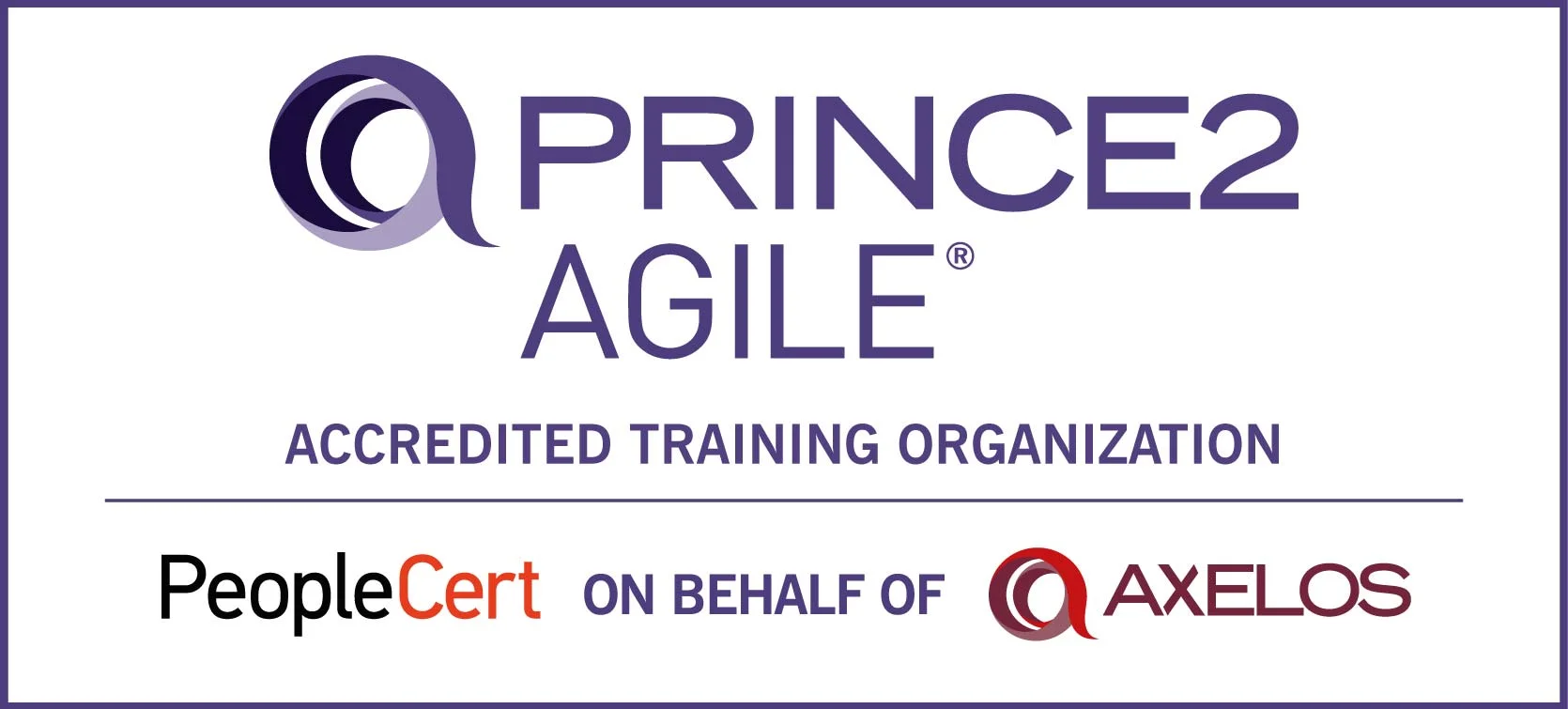What is Amazon S3 and What is Google Cloud Storage?
AWS S3 is an object level storage service by Amazon Web Services. It provides storage for unstructured data rather than file or volume data. So, AWS S3 stores its data as objects within buckets. With AWS S3, you can store any amount of data, create a data backup, or retrieve it at any time from any device.
Besides, AWS is used by companies worldwide to store and protect data for various use cases. These include mobile applications, websites, data lakes, IoT devices and big data analytics. Besides storage, AWS S3 provides management features. These features enable users to organize, optimize, and configure data access to meet specific business needs.
Google Cloud Storage is an object level storage platform by Google Cloud Platform (GCP). Primarily, it provides storage for unstructured data sets. Also gives you a flexible way of managing your storage. Ideally, Google Cloud Storage was designed as a competitor for AWS S3. When comparing Google Cloud Storage vs AWS S3, it's important to consider pricing, performance, and regional availability. The Google Cloud Storage vs AWS S3 debate often revolves around storage classes and their cost-effectiveness for different use cases.

Google Cloud Storage vs AWS S3: Pricing and Storage
AWS S3 is charged depending on your usage. Each storage class has different pricing depending on the amount of data stored. Besides, there are costs for data requests and retrieval, data transfer, replication, and Lambda.
For the S3 standard class (for frequently accessed data), the total cost of data storage is $0.023 per GB up to 500 TB. For data exceeding 500 TB, the total cost of data storage is $0.0021 per GB. S3 data archive in the Glacier Deep Archive tier costs $0.00099 per GB per month.
Storing data in the Standard Class (for frequent access) costs $0.02 per GB per month, while the Archive storage tier costs $0.0012 per month. The prices are very close, but if you consider other factors such as data transfer, replication, and retrieval, Google Cloud Storage is relatively cheaper than AWS S3. Security features in Google Cloud Storage vs AWS S3 differ, but both offer robust options for data protection and compliance. Understanding Google Cloud Storage vs AWS S3 can help businesses make the right choice based on their scalability and integration needs.
Amazon S3 vs Google Cloud Storage: Security
Focuses on the security features and protocols each service offers to protect data.
Encryption:
Both Amazon S3 and Google Cloud Storage provide robust encryption options for data at rest and in transit. S3 offers server-side encryption (SSE) options, including SSE-S3, SSE-KMS, and SSE-C, while Google Cloud Storage supports customer-managed encryption keys (CMEK) and default encryption.
Access Control:
S3 uses IAM policies and bucket policies to manage access, allowing granular permissions. Google Cloud Storage utilizes IAM roles and permissions, along with Object ACLs, for fine-grained access control.
Auditing and Compliance:
Both platforms offer logging capabilities—S3 with AWS CloudTrail and Google Cloud Storage with Access Logs—to monitor access and changes. They comply with various industry standards and regulations, including GDPR, HIPAA, and PCI-DSS.
Data Loss Prevention:
Each service provides tools for data redundancy and recovery, with S3 featuring versioning and cross-region replication, while Google Cloud Storage offers Object Versioning and automatic redundancy across multiple locations.
This comparison highlights the strengths and nuances of security features in Amazon S3 and Google Cloud Storage, helping organizations choose the best fit for their security requirements.
🚀 AWS vs. GCP: Which Cloud Suits You Best?
🎯 Compare Features, Pricing & Use Cases.
Key Features of AWS S3 and Key Features of GCS
AWS S3 is an object level storage service by Amazon Web Services. It provides storage for unstructured data rather than file or volume data. So, AWS S3 stores its data as objects within buckets. With AWS S3, you can store any amount of data, create a data backup, or retrieve it at any time from any device.
Besides, AWS is used by companies worldwide to store and protect data for various use cases. These include mobile applications, websites, data lakes, IoT devices and big data analytics. Besides storage, AWS provides management features. These features enable users to organize, optimize, and configure data access to meet specific business needs.
Google Cloud Storage is an object level storage platform by Google Cloud Platform (GCP). Primarily, it provides storage for unstructured data sets. Also gives you a flexible way of managing your storage. Ideally, Google Cloud Storage was designed as a competitor for AWS S3. To establish a connection between AWS S3 and AWS EC2, you can interact with S3 from an EC2 instance using various methods, such as the AWS CLI, SDKs, or even via REST APIs.
How AWS S3 Works and How Google Cloud Storage Works
How S3 Works
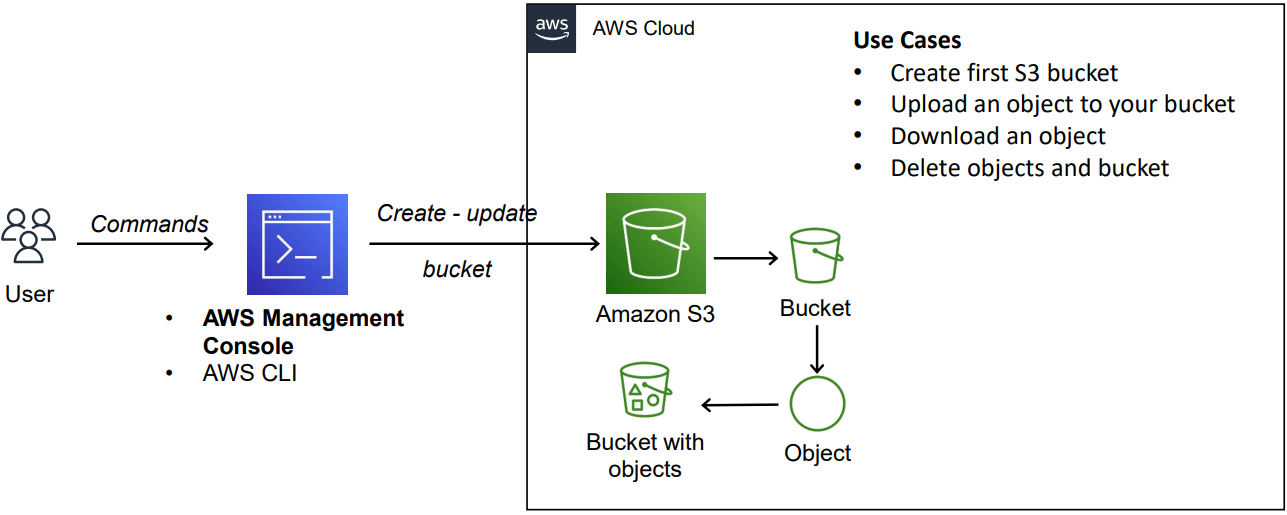
Amazon S3 data is stored as objects. This approach enables highly scalable storage in the cloud. Objects can be placed on a variety of physical disk drives distributed throughout the data center. Amazon data centers use specialized hardware, software, and distributed file systems to provide true elastic scalability.
Amazon provides redundancy and version control using block storage methods. Data is automatically stored in multiple locations, distributed across multiple disks, and in some cases, multiple availability zones or regions. The Amazon S3 service periodically checks the integrity of the data by checking its control hash value. If data corruption is detected, redundant data is used to restore the object.
Buckets:
A bucket is a container for storing objects in S3. Each bucket is uniquely named and exists within a specific AWS region. Users can create, delete, and manage buckets and set permissions at the bucket level.
Objects:
Objects are the actual files or data stored in S3. Each object consists of data (file content) and metadata (information about the file, such as size, timestamp, etc.). Each object in S3 is identified by a unique key within a bucket.
Regions:
Buckets can be created in specific AWS regions. Storing data in different regions can help achieve lower latency or fulfill regulatory requirements.
Access Control:
Access to S3 resources is controlled through IAM policies, bucket policies, and Access Control Lists (ACLs). Permissions can be set to allow or deny access to individual buckets or objects.
Storage Classes:
S3 offers multiple storage classes designed for different use cases and cost structures, such as S3 Standard, S3 Intelligent-Tiering, S3 Standard-IA (Infrequent Access), S3 Glacier, and S3 Glacier Deep Archive.
Data Management:
S3 provides tools for managing data, including Versioning (to track changes to objects), Lifecycle Policies (to automate data retention and deletion), and Replication (to copy objects between different buckets or regions).
Data Integrity & Security:
S3 supports server-side encryption (SSE) and client-side encryption to protect data at rest. It also integrates with AWS Key Management Service (KMS) for key management. Object Locking and MFA (Multi-Factor Authentication) Delete offer further protection for sensitive or critical data.
S3 Operations:
PUT Operation:
Used to upload an object to an S3 bucket. When you PUT an object, you can specify the storage class and any relevant metadata (like file type or cache control).
GET Operation:
Retrieves objects from the bucket. You can either download the object directly or use a signed URL for temporary access.
DELETE Operation:
Removes an object from a bucket. You can also delete entire buckets and all associated objects.
HEAD Operation:
Retrieves metadata about an object (without downloading the file).
LIST Operation:
Lists objects in a bucket, either by default or based on certain prefixes or filters.
Google Cloud Storage vs AWS S3: How GCS Works?
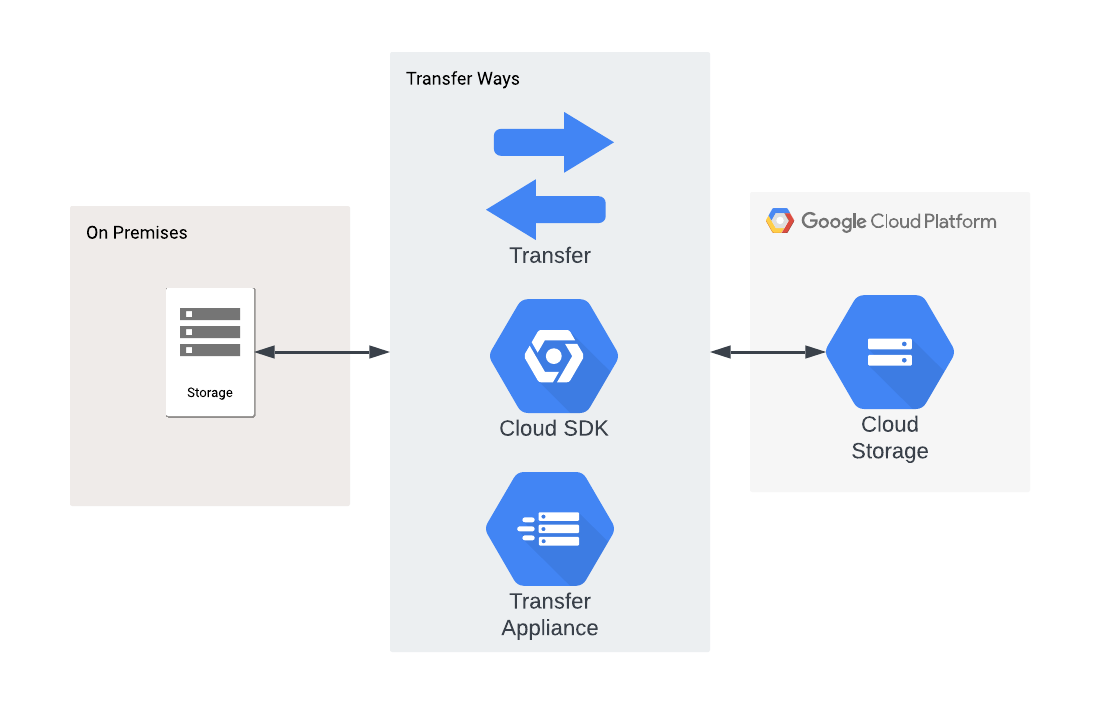
Google Cloud Storage (GCS) is a scalable and secure object storage service provided by Google Cloud. It allows users to store and manage large amounts of unstructured data, such as media files, backups, and data archives.
Buckets:
A bucket is the main container for storing objects in GCS. Each bucket is uniquely named and associated with a project.
Buckets define access controls and the geographic location where the data is stored.
Users can create, delete, and manage buckets.
Objects:
Objects are the actual data (files) stored in GCS.
Every object consists of the data itself (such as a file) and associated metadata (like content type, size, etc.).
Each object within a bucket has a unique key, which is the object’s name.
Storage Classes:
GCS provides various storage classes to optimize costs based on the frequency and speed of access. These include:
Standard: Best for data that is accessed frequently.
Nearline: Suitable for data that is accessed less than once a month.
Coldline: For data accessed less than once a year.
Archive: For long-term storage with very infrequent access.
You can change the storage class of an object without moving the data to a different bucket.
Key Features:
Data Redundancy:
GCS automatically replicates data across multiple locations to ensure durability and availability.
The data can be stored in different locations:
Regional: Data is stored in a single region for low-latency access within that region.
Multi-Regional: Data is stored across multiple regions, providing higher availability.
Dual-Regional: Data is stored in two specific regions for redundancy.
Access Control:
Access to buckets and objects is controlled through Identity and Access Management (IAM) roles, Access Control Lists (ACLs), and bucket policies.
These controls allow for fine-grained permissions for users, projects, or applications accessing the data.
Object Versioning:
GCS supports versioning, which allows you to keep multiple versions of an object in the bucket.
This helps in recovering previous versions of objects in case of accidental deletion or modification.
Lifecycle Management:
You can define lifecycle policies to automate tasks such as transitioning objects to lower-cost storage classes, archiving, or deleting them based on specific conditions.
Encryption:
GCS encrypts data by default using Google-managed keys.
It also supports customer-managed encryption keys (CMEK) via Google Cloud Key Management Service (KMS), allowing more control over encryption keys.
Data Transfer:
GCS supports uploading and downloading data via the Google Cloud Console, gsutil (command-line tool), and APIs.
It also provides Signed URLs to allow temporary access to private data without exposing credentials.
Cross-Bucket Operations:
GCS supports Object Replication, which allows objects to be automatically copied from one bucket to another in different locations, ensuring data durability and availability in multiple geographic regions.
Event Notifications:
You can set up event notifications for various operations (e.g., when an object is created or deleted) and trigger Cloud Functions or Pub/Sub for automation.
Use cases for s3 and GCS
Amazon S3 Use Cases
- Data Backup and Recovery: S3 is often used for storing backups of critical data and applications, providing durability and redundancy.
- Big Data Analytics: Organizations can store large datasets in S3 for analytics using services like Amazon Athena or Redshift, allowing for scalable data processing.
- Static Website Hosting: S3 can host static websites by serving HTML, CSS, and JavaScript files directly, with built-in high availability.
- Media Hosting and Streaming: S3 is used to store and serve media files (images, videos, audio) for applications, allowing for seamless streaming and access.
- Data Lake: S3 can serve as a central repository for a data lake, storing structured and unstructured data for various analytics purposes.
Google Cloud Storage Use Cases
- Data Archiving: GCS provides low-cost options for archiving data that is infrequently accessed but must be retained, such as regulatory compliance data.
- Machine Learning: GCS is commonly used to store training data and model artifacts for machine learning workflows, integrating seamlessly with Google AI and ML services.
- Content Delivery: GCS can be used to store and serve content for web applications, leveraging its global infrastructure for fast access and low latency.
- Application Data Storage: GCS is suitable for storing application data such as user uploads, logs, and configuration files for applications hosted on Google Cloud.
- Data Sharing: GCS facilitates easy sharing of data between users and applications, with fine-grained access controls and integration with other Google Cloud services.
Performance and speed are critical factors in deciding between Google Cloud Storage vs AWS S3, especially for data-intensive applications.
Author Details

Vaibhav Umarvaishya
Cloud Engineer | Solution Architect
As a Cloud Engineer and AWS Solutions Architect Associate at NovelVista, I specialized in designing and deploying scalable and fault-tolerant systems on AWS. My responsibilities included selecting suitable AWS services based on specific requirements, managing AWS costs, and implementing best practices for security. I also played a pivotal role in migrating complex applications to AWS and advising on architectural decisions to optimize cloud deployments.
Confused About Certification?
Get Free Consultation Call

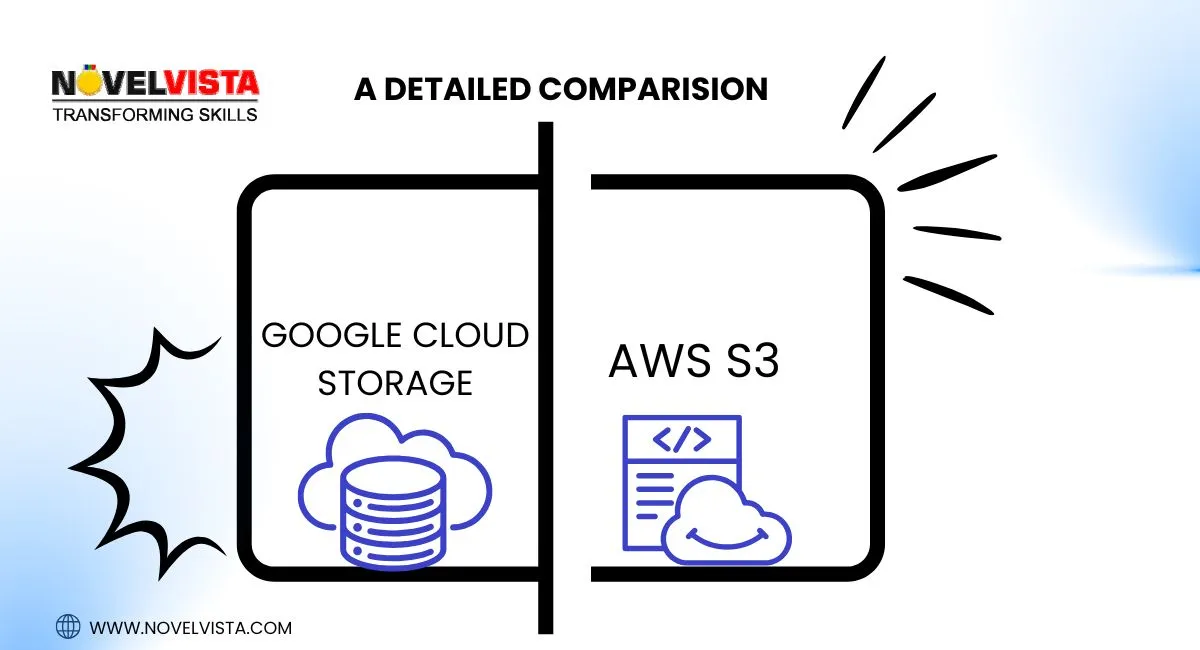
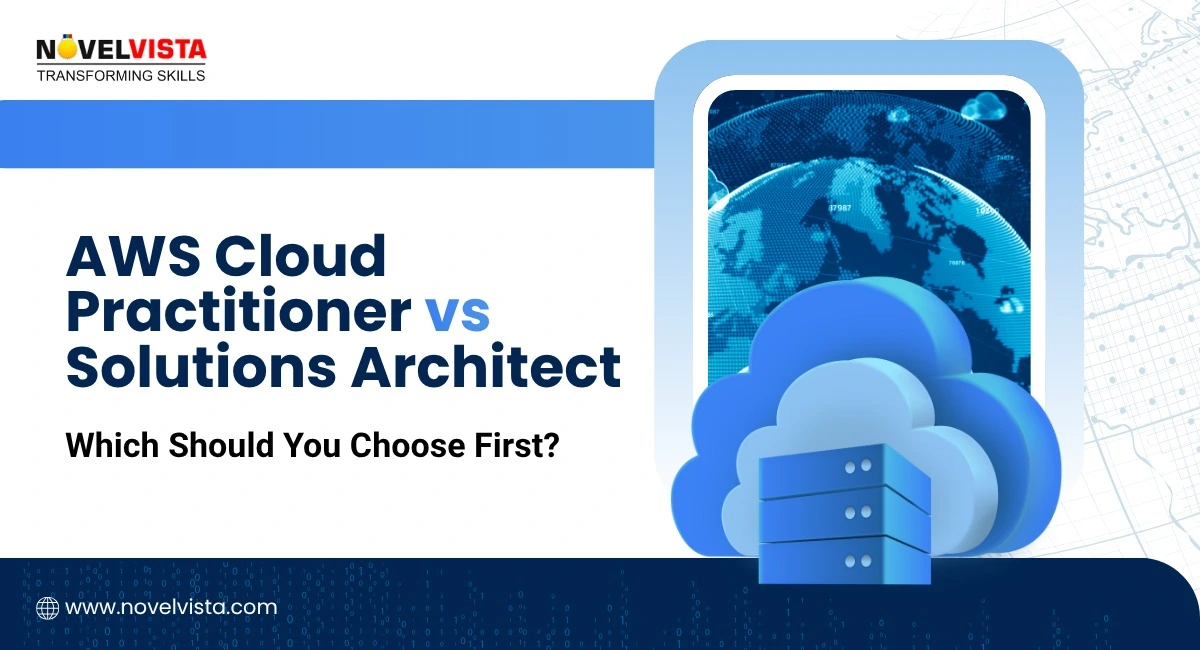

![Free AWS Solutions Architect Associate Practice Exam: No Signup, Instant Results! [Hands-on Prep] | Novelvista](https://www.novelvista.com/resources/images/blogs/other/aws-solutions-architect-mock-exam-featured.webp)

